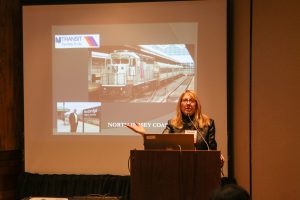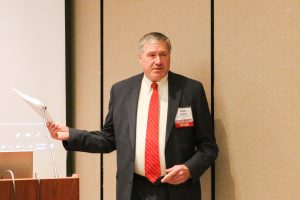Session Summary
Community leaders agree: Public art is an invaluable tool for thoughtful redevelopment
Caroline Ehrlich, Tom Goletz, Lauren Otis, and Elena Cromeyer work very different jobs, in different sized communities, with different constituents, but they all agree on one thing: public art can be an invaluable tool in successful redevelopment. The four panelists came together to share their thoughts as part of New Jersey Future’s 2020 Redevelopment Forum session entitled, Everyone’s a Critic: Public Art’s Role in Redevelopment. The panel identified public art as an important mechanism for growth and development, specifically enumerating positive effects on economic redevelopment, safety, and placemaking. The panelists took time to share their experiences, and to provide examples of public art projects and complementary art initiatives that contributed mightily to the public health, economic health, and vibrancy of the communities that they serve.

Caroline Ehrlich, Chief of Staff of Woodbridge Township, and Executive Director of the Woodbridge Township Redevelopment Agency.
As Chief of Staff of Woodbridge Township, and Executive Director of the Woodbridge Township Redevelopment Agency, Caroline Ehrlich has firsthand experience with developing a thriving arts community. “The mayor was convinced that art would trigger economic development,” Ehrlich commented. She spoke about the importance of meticulous planning and creating an arts inventory and steering committee to foster a creative environment where artists would be comfortable. “We just started knocking on doors.” Knocking on doors led to the creation of the steering committee, and now Woodbridge is home to the Avenel Performing Arts Center, the AvenelMural Project, and many supporting businesses. “Now there are plenty of reasons why artists would want to live in Woodbridge,” Ehrlich proudly shared.
Tom Goletz, Vice President of Newark Downtown District, shared his experiences with the “Gateways to Newark” mural project, and how it involved artists from around the world, as well as the entire downtown community. The mural is located on an Amtrak wall along McCarter Highway, and features art pieces that pay homage to Newark’s history, present and future. It is the second longest mural in the country, and is about the length of 25 football fields. It was completed in 13 days, at night, and required working with many partners to achieve their goal of creating a healthier, safer, and more vibrant gateway to the city of Newark. Multi-stakeholder involvement was crucial to the project, and extended from the Mayor’s office down to the artists and community members. Goletz credits their curator and community ambassador program with fostering an inclusive environment and ensuring the overall success of the project.

Tom Goletz, Vice President of Newark Downtown District.
Through the lens of an artist, Lauren Otis, Executive Director at Artworks, provided numerous examples of art installations that have greatly contributed to thriving communities throughout the world. “Public art will connect a community, create a community, and create a sense of place…it’s value is huge. Otis detailed works in various sizes, mediums, and even permanence all over the world. His examples made the point that art can work with any space and budget. “You don’t have to do something like a monolithic piece of art. You can have new art, and interchangeable art.” Lesser known mediums, such as light installations, can also be employed in a comprehensive redevelopment vision to solve real public safety and economic development issues. Otis discussed projects in Spartanburg South Carolina, San Jose California, Boston Massachusetts, Mobile Alabama, and Philadelphia Pennsylvania, which all provided a solution to the universal problem of dead zones, like underpasses, which can be dark, difficult, and scary.
Focusing specifically on redevelopment and problems related to public health, Elena Cromeyer stressed creative placemaking to make communities healthier and safer. “Placemaking can improve public health by building community, shifting behaviour, and providing public access to fresh food and greenery,” she stated. As Project Director for the non-profit Trenton Health Team, Cromeyer detailed local projects where art improves the lives of community members by tackling issues such as nicotine and tobacco use, childhood obesity, and violence. The rainbow crosswalk project on Warren Street in Trenton is an example of creative placemaking to beautify an unsafe and busy area that also promotes civic pride. “These projects are not without their challenges,” Cromeyer relayed. She also discussed important projects that have encountered hurdles due to public art not having a stronger position in today’s redevelopment infrastructure. Artwalk Trenton is a proposed project that has been halted for these reasons, and Cromeyer is concerned that a lack of public art policy is perpetuating a less safe and unhealthy environment for community members.
Through all of their presentations, the speakers agreed that thoughtful planning, inventory of resources, and a comprehensive vision of success are extremely important in employing public art as a redevelopment tool. Too often dismissed as an ancillary or “nice to have” addition to a redevelopment plan, public art should be a more important part of the overall redevelopment discussion. Universal issues such as public health and safety can be adequately addressed if public art is included as an available option in redevelopment infrastructure.
This summary was written by Bree Callahan from New Jersey Future.